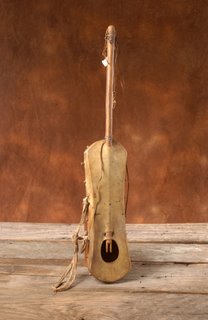History of the Banjo
For many of us from the Appalachian Mountains the first pluck of a banjo string wakes us up like the smell of Sunday morning bacon and gravy in the skillet. It is the same awareness of my mom yelling all three of my names at the same time. We stand up straight, waiting. But as we gear ourselves to be called home we do not realize the history of this instrument and what it means to hear that edgy tone that has become a sound that can sooth us all. The “American” style banjo came from the arrival of African-American slaves. In transport from Africa these descendents were not allowed to play drums and so turned to a new construction of instrument that derives from the West Senegal “Xalam” (image below).
The players at the time took a simple cut gourd or turtle shell with a fretless stick perturbing from the top, wrapped the body in any kind of dried animal skin and then placed tightened strings, cat guts, hemp, or wire to the body. This was the beginning of the “American Four String Banjo.” European Americans saw the first creation of the banjo as an instrument lower than the fiddle that they often referred to as the instrument of the devil. At this time the only individuals who played banjo were black slave workers thus when Joel Walker Sweeney of Appomattox C.H. VA learned to play at the age of 13 he then changed the course of the instrument. Sweeney took his knowledge of his mentors and started to travel through Virginia as a minstrel “circus” show. Sweeney learned how to pick the banjo like all of his peers. During the first part of the 19th century the only style of playing was what we now call “clawhammer style” Clawhammer comes from the placement of the fingers on the banjo strings when you strike the string with the back of your fingernail and the thumb. Clawhammer was the original way of playing banjo and once again goes back to how musicians plucked instruments in Africa.
Sweeney became an instant success and started his own minstrel show with his brothers Sam and Dick. The show toured the eastern coast and prospered in New York City. Billy Whitlock, one of Sweeney's many students, joined with Dan Emmett, whom learned the banjo from the West Virginia native ??? Ferguson and formed the Virginia Minstrels in 1843 and launched the minstrel craze. The main outlet for minstrel bands was the circus. Being a part of the circus at the time was appealing as the then “rock stars” of the world were minstrel players. Therefore a large push of boys learned to play the banjo just to join the circus. This instrument soon flourished into the main stream and even launched national calls and competitions to find the best banjo player/s. Because of the traveling minstrel shows the sound of banjo and fiddle began to fit together and became so important as bother instruments. To have a true performance a band had to have both banjo and fiddle. This is why when we now hear a banjo and a fiddle together everything sounds right.
During the Civil War thousands of young banjo players joined the army on both sides and the banjo playing style was fined tuned. It was right after the war that a new style playing came about which we now refer to as the “finger-picking.” This style can be dated back to James Buckley in 1865 when he released his own player’s manual for those who wanted to learn a simpler and more classical style of playing. In 1880 the fret on the banjo neck appeared from a manufacturer in NY by the name of Henry Dobson. Dobson decided that with the fingerpicking style one needed to see the locations of the higher points of the neck. These manuals and fret banjos started to sell like hot cakes thus causing the decline of our clawhammer style. But, in the mountains of Appalachian where the banjo was taught by personal instruction instead of by books the Clawhammer style remained. When you listen to the music rolling from the smooth Appalachian hills remember that that clawhammer banjo recalls the past and our roots. It is the original and has lasted over 200 years.




3 comments:
looks like a great blog. i'll start checking regularly to see if you post.
Go to banjohistory.com or dhyatt.com for a more comprehensive history of the Appalachian banjo. George
fall fashion trends 2011 | synonym dictionary | japanese bed
flowers pictures | kitchen ware | butternut squash recipes
rental agreement | healthy dinner recipes | atlanta furniture stores
weather in Vancouver | names for girls | simple recipes
Post a Comment